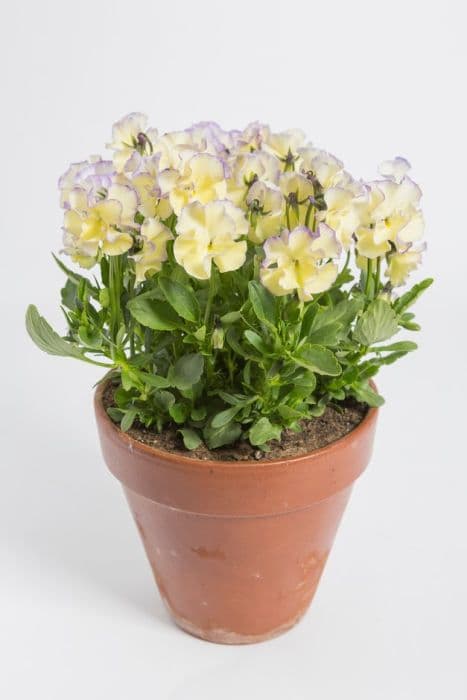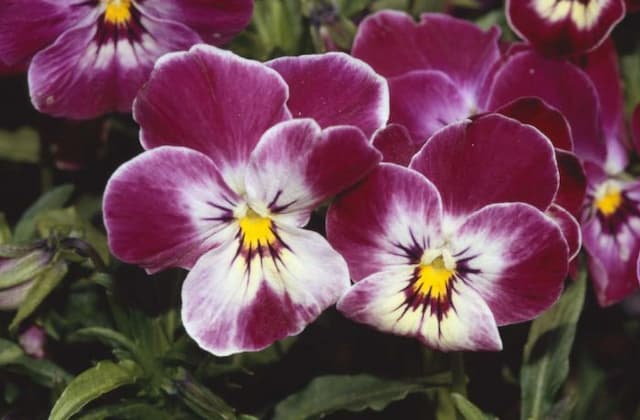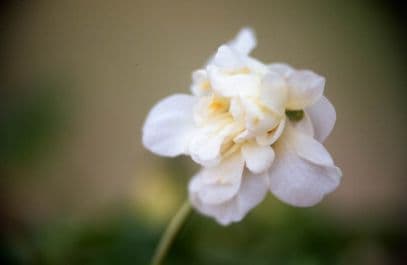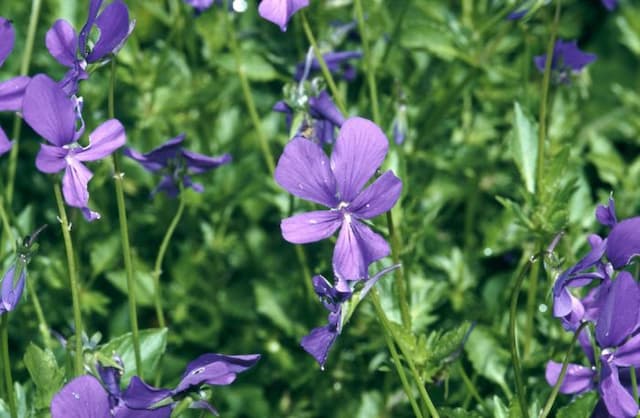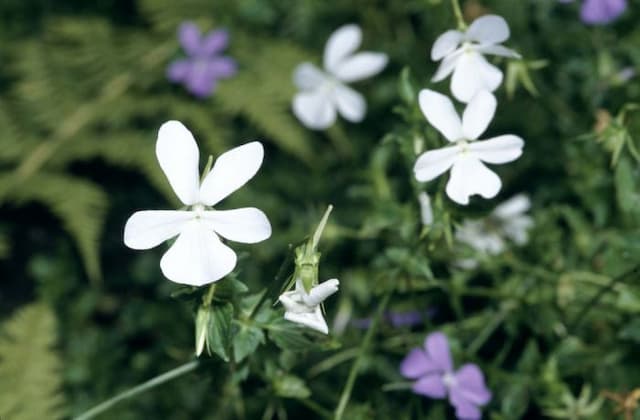Sweet violet Viola odorata (Vt)

ABOUT
The sweet violet, which is known for its fragrant and often purple-colored flowers, has a distinct appearance characteristic of woodland habitats and gardens where it favors. The foliage is made up of heart-shaped, green leaves that usually maintain their color throughout the year. These leaves are slightly ruffled at the edges and grow close to the ground, providing a dense ground cover in areas where the plant thrives. At the first hint of spring, the sweet violet produces its namesake blooms, which are typically deep violet or purple but can also come in shades of blue, and occasionally white and pink. The flowers have a symmetrical structure, with five petals that are fused at the base forming a short tube. The lower petal often has a lighter or white center, which includes delicate veins running through it, presumably as a guide for pollinating insects. The bloom gives off a sweet and heady fragrance, which has been cherished and used in perfumery for centuries. After flowering, the plant develops small, round fruits that are capsules containing seeds, enabling the sweet violet to propagate and spread across favorable areas. Overall, the sweet violet holds a classic charm, its flowers providing an early splash of color and scent in a variety of settings.
About this plant
 Names
NamesFamily
Violaceae.
Synonyms
Sweet Violet, English Violet, Common Violet, Garden Violet, Scented Violet, Wood Violet, Flower Of Modesty, Queen Of The Woods.
Common names
Viola suavis, Viola philippica, Viola feinbruniae, Viola splendens, Viola paradoxa, Viola baumgartenii, Viola cenisia, Viola constantinopolitana, Viola declinata, Viola intricata, Viola odorata var. subvestita, Viola corsica, Viola hortensis, Viola ambigua, Viola odoratissima, Viola jacquinii, Viola bertolonii, Viola discolor, Viola elegans, Viola endressii, Viola parvula, Viola perpusilla, Viola rothomagensis, Viola vagans, Viola vicentina, Viola belgica.
 Toxicity
ToxicityTo humans
Sweet violet is generally considered safe for human consumption; however, it is important to consume it in moderation. The flowers and leaves of sweet violet are historically used in cooking and for medicinal purposes. To date, there are no significant reports of toxicity or poisoning from consuming sweet violet in reasonable amounts. Overconsumption or misuse could potentially lead to mild gastrointestinal discomfort due to the saponins present, which can have a mild laxative effect, but typically sweet violet is not associated with serious health risks when consumed by humans.
To pets
Sweet violet is generally considered non-toxic to pets, including cats and dogs. The flowers and leaves may be ingested without causing harm. However, while not considered poisonous, any plant material can potentially cause reactions in pets such as gastrointestinal upset if eaten in large amounts. The typical response, if any, might be mild vomiting or diarrhea, but sweet violet is not known for causing severe toxicity or long-term health issues in pets when ingested. Owners should always monitor their pets for any adverse reactions when they consume plant matter.
 Characteristics
CharacteristicsLife cycle
Perennials
Foliage type
Evergreen
Color of leaves
Green
Flower color
Purple
Height
4 inches [10 cm]
Spread
1 foot [30 cm]
Plant type
Herb
Hardiness zones
5
Native area
Europe
Benefits
 General Benefits
General Benefits- Edible Parts: Viola odorata (sweet violet) has edible flowers and leaves that can be used in salads, desserts, and as garnishes.
- Aromatic Qualities: The sweet-scented flowers are used in perfumery and to add fragrance to lotions and other beauty products.
- Garden Aesthetic: Sweet violet adds beauty to gardens with its attractive foliage and delicate, typically purple flowers.
- Culinary Uses: The flowers are sometimes crystallized as decorative and flavorful confections or used to flavor syrups and teas.
- Wildlife Attraction: Sweet violet flowers can attract pollinators such as bees and butterflies, enhancing biodiversity.
- Cultural Significance: Viola odorata has a long history of symbolism, particularly in literature and art, symbolizing love, affection, humility, and faithfulness.
- Ground Cover: The plant can function as a ground cover in shaded areas, helping to reduce weed growth and soil erosion.
 Medical Properties
Medical Properties- Expectorant: Viola odorata has been traditionally used to loosen phlegm and relieve chest congestion.
- Anti-inflammatory: Contains compounds that may help reduce inflammation.
- Diuretic: May increase the excretion of urine, which can be useful in conditions like edema.
- Analgesic: May offer pain relief for minor aches and headaches.
- Sedative: Has mild sedative properties that may help induce sleep and reduce anxiety.
- Antirheumatic: Has been used in traditional medicine to relieve rheumatic pain.
- Antioxidant: Contains flavonoids and anthocyanins which may protect cells from oxidative damage.
- Mild laxative: Can be used to relieve constipation in a mild manner.
- Skin health: Traditionally used for treating mild skin disorders due to its soothing properties.
- Respiratory health: Used in traditional medicine to treat colds, cough, and sore throat.
 Air-purifying Qualities
Air-purifying QualitiesThis plant is not specifically known for air purifying qualities.
 Other Uses
Other Uses- Viola odorata, also known as sweet violet, can be used as a natural dye, producing colors ranging from green to blue on fabrics and textiles.
- In the culinary realm, sweet violet petals are sometimes coated in egg white and sugar to create candied violets for decorative dessert garnishes.
- The flowers of sweet violet are often used in perfumery as a source of 'orris oil' which is valued for its violet-like fragrance.
- Sweet violets can be used as an ingredient in floral syrups which are then incorporated into cocktails or non-alcoholic beverages for a subtle floral note.
- Viola odorata has been traditionally used in the manufacture of certain types of incense, appreciated for its sweet and calming scent.
- As a natural flavor agent, the leaves and flowers of sweet violet impart a mild and distinctive flavor to jellies, jams, and preserves.
- The plant's essence is sometimes infused into honey, yielding a uniquely flavored sweetener for teas and pastries.
- Whole sweet violet plants can be used in potpourri mixtures, lending a long-lasting fragrance profile to the mix.
- Sweet violet petals are also utilized in the craft of paper-making to create decorative paper with floral inclusions.
- During the Victorian era, sweet violets were used in tussie-mussies, small bouquets of flowers and herbs carried to mask unpleasant odors in public spaces.
Interesting Facts
 Feng Shui
Feng ShuiThe Sweet Violet is not used in Feng Shui practice.
 Zodiac Sign Compitability
Zodiac Sign CompitabilityThe Sweet Violet is not used in astrology practice.
 Plant Symbolism
Plant Symbolism- Love: Sweet violets often symbolize love and affection, possibly due to their sweet fragrance which can be reminiscent of the tender emotions associated with love.
- Modesty: The small size and subtle presence of the violet can represent modesty or humility, suggesting a quiet, unassuming nature.
- Faithfulness: Violets are also symbolic of faithfulness, loyalty, and devotion, which could be associated with the flower's tendency to grow in faithful clumps.
- Humility: Closely related to modesty, the humility of the violet speaks to its low-growing habit and the way it can sometimes be overlooked despite its beauty.
- Spirituality: Violets can symbolize a deep spiritual love and truth, and are often used in religious art to convey such themes.
- Recollection: Violets have a longstanding association with remembrance, which is why they are often present in wreaths and memorials.
 Water
WaterSweet violet (Viola odorata) prefers consistently moist soil, so it should be watered whenever the top inch of soil feels dry to the touch. This will typically mean watering every few days, but frequency may vary depending on factors such as temperature, humidity, and soil type. An ideal method is to use a watering can to gently apply water directly to the soil, avoiding wetting the leaves which could lead to fungal diseases. Aim to provide approximately one gallon of water per square foot every week during the growing season. Adjust watering during rainy periods or hot, dry spells to ensure the soil stays moist but not waterlogged.
 Light
LightSweet violet thrives in partial shade to full shade where it can be protected from the harsh afternoon sun. The best spot for this plant would be under the light dappled shade of a tree or on the north side of a building where it gets filtered sunlight. Consistent, indirect light will encourage healthy growth without scorching its delicate leaves.
 Temperature
TemperatureSweet violet prefers cooler conditions and fares best in a temperature range between 40 and 70 degrees Fahrenheit. It can survive minimum temperatures down to about 20 degrees Fahrenheit, making it hardy in cooler climates. During hot weather, it's crucial to keep the plant cool and shaded, as temperatures consistently above 80 degrees Fahrenheit can stress the plant.
 Pruning
PruningPrune sweet violet after it has finished blooming to promote new growth and remove any spent flowers or damaged leaves. Light pruning helps maintain a compact, bushy form and encourages air circulation within the plant, which can reduce the risk of disease. The best time for pruning is late spring or early summer, after the flowering period. It's generally not necessary to prune more than once a year unless the plant becomes overgrown or needs shaping.
 Cleaning
CleaningAs needed
 Soil
SoilThe best soil mix for Sweet Violet (Viola odorata) is one that's rich, moist, and well-draining, with a good mix of loam, compost, and possibly leaf mold. The soil pH should be slightly acidic to neutral, ideally between 6 and 7.
 Repotting
RepottingSweet Violet typically requires repotting every 2-3 years, though it can often spread on its own if given the space to grow naturally.
 Humidity & Misting
Humidity & MistingSweet Violet thrives best in moderate humidity conditions; it tolerates normal indoor humidity levels but benefits from occasional misting.
 Suitable locations
Suitable locationsIndoor
Place in bright, indirect light and ensure high humidity.
Outdoor
Partial shade, moist soil, sheltered from wind.
Hardiness zone
4-9 USDA
 Life cycle
Life cycleViola odorata, commonly known as sweet violet, typically begins its life cycle with seed germination, which occurs in spring after the seeds have been stratified over winter to break dormancy. The seedlings develop into rosette-forming juvenile plants with heart-shaped, dark green leaves. As the plants mature, they produce characteristic fragrant purple flowers, usually in early spring, although they can also flower sporadically in fall. These flowers are self-fertile and can produce seeds for the next generation, as well as reproduce vegetatively through stolons, which are horizontal stems that produce new plantlets at their tips. Sweet violet then enters a period of summer dormancy in hot climates, with growth resuming as temperatures cool in fall. The plant lives as a perennial, completing this cycle annually and potentially living for many years in favorable conditions.
 Propogation
PropogationPropogation time
Spring
The most popular method of propagating sweet violet (Viola odorata) is through division of the rhizomes. This is best done in the fall, after the flowering period and when the plant is in its dormancy phase. Carefully dig up the plant, ensuring you maintain a good amount of soil around the roots to reduce shock. The rhizomes can be gently pulled apart by hand, ensuring each division has a portion of the roots. These divisions should then be replanted at the same soil depth they were previously growing, spaced about 6 to 12 inches (15 to 30 centimeters) apart to allow ample room for growth. After replanting, water the divisions thoroughly to help establish them in their new locations. This method of propagation allows the sweet violet to quickly establish a new, healthy clump and begin growing again come spring.
